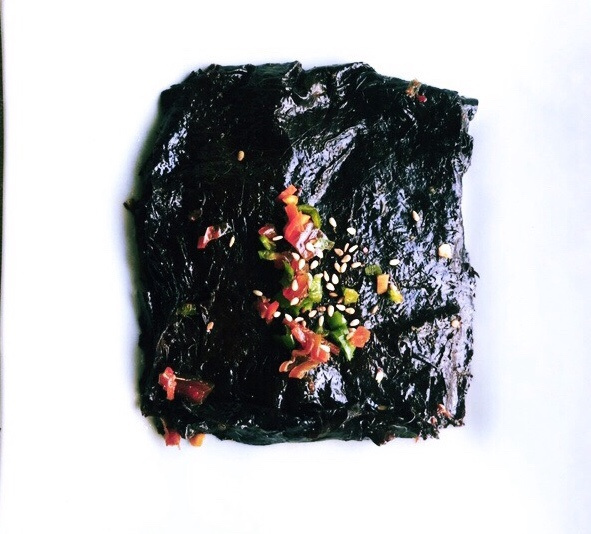Delicious Aged Seaweed Pickle (Kim Jangajji)
How to Make Tasty Kim Jangajji from Stale Seaweed

Do you love seaweed and often stock up on dried or crispy seaweed sheets? During the humid summer months, especially the rainy season, seaweed can quickly become soggy and unappealing. This often leads to leftover seaweed that goes stale, making it even harder to consume. Stale seaweed loses its crispness and color, sometimes developing an unpleasant smell, turning it into a problem ingredient. Kim Jangajji is the perfect solution to use up all that stale seaweed at once! Soggy, stale seaweed transforms into a delightfully moist, savory, and umami-rich pickle. Placing a sheet on your rice creates a delicious side dish that’s so satisfying, you might finish a whole bowl of rice without needing anything else. The marinade for this Kim Jangajji is adapted from my secret Perilla Leaf Jangajji recipe. Using the same sauce and layering blanched perilla leaves creates an incredibly tasty perilla leaf pickle. However, when making Kim Jangajji, it’s crucial to let the cooked marinade cool completely before using it. Pouring hot marinade directly onto the seaweed will cause it to disintegrate. Please ensure the marinade is thoroughly cooled before proceeding.
Ingredients- 50 sheets of dried seaweed (Gim)
Marinade- 200ml Soy sauce (for seasoning)
- 2 Tbsp Sugar
- 2 Green onions (chopped)
- 15 cloves Garlic (minced)
- 1 small piece Ginger (minced)
- 1 Carrot (finely chopped)
- 1 Onion (finely chopped)
- 1 Tbsp Gochugaru (Korean chili powder)
- 2 Tbsp Olive oil
- 100ml Water
- 1 Tbsp Sesame oil
- 1 Tbsp Toasted sesame seeds
- 200ml Soy sauce (for seasoning)
- 2 Tbsp Sugar
- 2 Green onions (chopped)
- 15 cloves Garlic (minced)
- 1 small piece Ginger (minced)
- 1 Carrot (finely chopped)
- 1 Onion (finely chopped)
- 1 Tbsp Gochugaru (Korean chili powder)
- 2 Tbsp Olive oil
- 100ml Water
- 1 Tbsp Sesame oil
- 1 Tbsp Toasted sesame seeds
Cooking Instructions
Step 1
First, let’s prepare the marinade, which is key to the deliciousness of this Kim Jangajji. In a pot, combine the finely chopped green onions, garlic, ginger, carrot, and onion. Add the soy sauce, sugar, gochugaru, olive oil, and water. (Set aside the sesame oil and sesame seeds for later.) Cover the pot and simmer over medium heat for about 10 minutes, allowing the flavors of the vegetables to meld. It’s crucial to let this cooked marinade cool down completely. Pouring hot marinade onto the seaweed will make it fall apart, so ensure it’s cooled thoroughly before use.

Step 2
While the marinade is cooling, prepare the seaweed. Spread about 20 sheets of seaweed onto a large plate or tray. Place it in the microwave and toast for 30 to 40 seconds. This slight toasting helps the stale seaweed regain a little crispness, making it easier to handle and better for absorbing the marinade without becoming mushy. Be careful not to over-toast, as it can burn.

Step 3
Once toasted, cut the seaweed into bite-sized pieces. Slice each sheet into approximately 6 or 8 portions. Cutting them into smaller pieces ensures that the marinade is evenly distributed and makes them easier to eat.

Step 4
Now, it’s time to assemble the Jangajji. Stack about 4 to 5 pieces of the cut seaweed. Then, using a spoon, ladle a spoonful of the cooled marinade over the stacked seaweed sheets, ensuring it’s spread evenly across the surface. Make sure the marinade seeps into all the layers.

Step 5
Continue layering the seaweed and drizzling with marinade until all the seaweed is used. Once all the seaweed is layered and coated, gently flip the stack over once to ensure the marinade penetrates evenly throughout. This process will make the seaweed delightfully moist and flavorful. Finally, drizzle with sesame oil and sprinkle with toasted sesame seeds for an extra touch of aroma and taste. Your delicious Kim Jangajji is ready!



